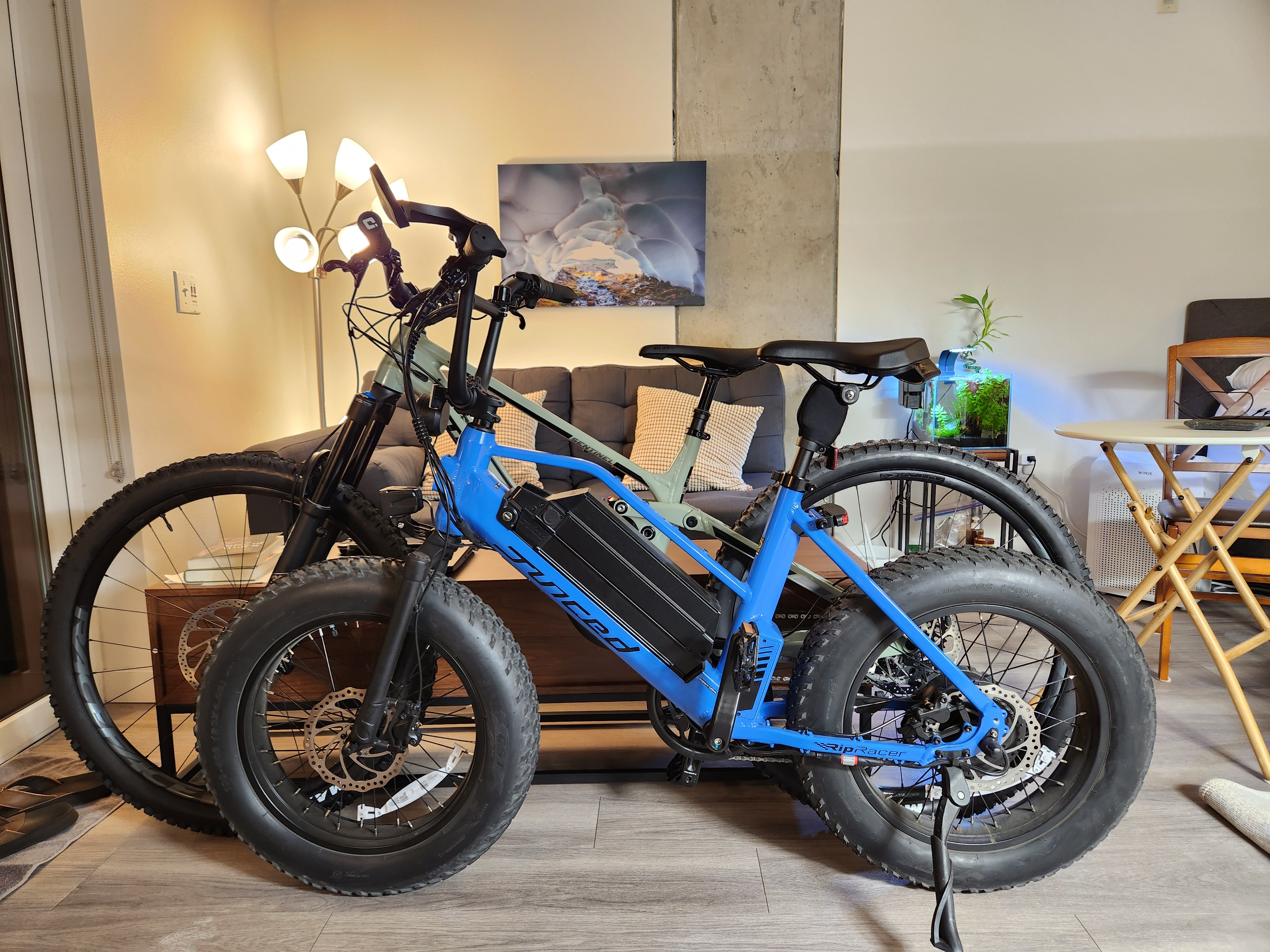Nobody likes getting a sore bum when cycling. The Air Seat is made with that fact in mind, as it adds what is described as a “full-floating” coil suspension system to existing saddles.
This always pops up in one form or another. Out of a chain of 3 shops, as the Buyer, I’ve probably swap meet liquidated a half dozen similar devices over the years, most were OEM types that came with a bike or were swapped and tossed after a casual bike fit.
It is primarily a thing for misguided people that have a poorly fitting bike and specifically the saddle. Suspension on bikes is not at all like inexperienced people imagine. I have a $4k Cannondale Jekyll still somewhere in storage. I’m primarily a roadie and former racer. Even on a 6in travel hardcore enduro trail bike like my Jekyll, the suspension is not for my ass; it is for control and handling while taking hits that would cause me to lose control otherwise. When the suspension is doing its thing, I’m definitely not in the saddle. Anyone that is buying a suspension bike that is doing so for a “soft ride” is simply making their bike much heavier and therefore harder to ride.
The soreness from a saddle is due to the soft tissue around your sit bones, and/or an overly stiff bike made of aluminum. You need the right shape of saddle for your anatomy. Extra padding and this kind of nonsense will only make matters worse. Real pros, of which I have worked with directly as the distribution hub for the ShoAir pro team, ride whatever they are sponsored to ride, but generally prefer the thinnest padding possible. I’ve ridden double centuries at over 200 miles in a day and likewise want as thin as possible to minimize problems. There is no solution the the stiffness problem of an aluminum frame. You’ll fatigue quickly from the high frequency vibrations quickly. I can’t tell you how many I tried when promised that the next demo bike was the greatest ever. The only exception being the Cannondale CAAD10 or higher. Those have nearly steel frame-like compliance, but no other brand came close to that experience out of any that I was given as demo’s, rode at demo days, or at interbike.
Ultimately, no bike suspension can match the suspension travel of your legs. Real suspension is not for little bumps, it is for hard charging a rock garden of basketball size material without slowing down while going 30 mph down hill. Everything else is a marketing gimmick. There is no replacement for the proper compliance built into a rigid frame’s rear triangle. You may notice the sharp bumps more after riding for awhile, but the fatigue is actually from the higher frequency vibrations. With a bad bike, you’ll feel the difference of the texture of concrete versus asphalt. No saddle, pad, or seat post can make that better. Your actual sit bones are what you are resting on, and anything that does not directly support those two little points naturally is making a problem worse.
Great write-up, completely misunderstanding the market they’re aiming for.
If you watched their promotional vid in the article, it’s definitely aimed at casual cyclists and urban commuting
Not that I’d buy one, I got one of those Selle Royale seats and it’s like a fuckin sofa 😂
Are you aware of an overview of what anatomy fits which saddle? E.g. what does my fat ass need to not hurt for days after a couple of kilometres on my gravel bike?
Fizik does a good job of breaking down the shapes into 3 primary types. You are likely aligned with “the Bull” (Aliante) basic type shape, although this is in terms of road riding. A more upright geometry requires a different shape overall, but something with more curve and contour that extends a bit lower on the sides will likely help. In their terminology, you’re probably “less flexible.” This is all marketing mumble jumbo that is designed to get you locked in to the brand illogically. However, the principal of threes dictates that retail customers are happiest when they are offered three options in any product category. When I did my preseason ordering for saddles in the shops, regardless of what brand I was buying, I thought about the products overall in terms of the three types Fizik markets the road saddles under. These shapes also have an associated width difference. This is how I think of saddles and would stock the stores: 3 choices in the 3 types, plus 3 mountain, 3 triathlon, and 3 absolute lowest price I could find options.
There is an element of tolerance. Like it is debatable whether you break in a saddle or a saddle breaks in you, at least initially.
Here are the basic shapes just to show you the profiles:
The Aliante is on the left, middle is snake, right is chameleon. Marketing of flexibility below. Lastly a side profile showing how the saddle has more curve front to back as well.



Remember this is road bike specific where exact fit is far more important than elsewhere. Mountain saddles are less exaggerated in shapes. You’re expected to spend far less time on the bike and in the saddle so the fit is different and less pronounced. On mountain, your riding position is more upright for visibility and that is a compromise in your riding position. I ride the same saddle on road and mountain because I rarely ride mountain and my saddle fits me well. There is also the factor of bike fit with height and setback causing potential issues. If your seatpost is set too high, your hips will rock and can cause saddle related issues; if it is too low, you’ll feel it in knee pain.
Hopefully I have communicated the abstract principal and context that will help you develop productive expectations overall when looking at the various saddles available.
Wow thanks a lot!
In before “hot air up one’s bum” jokes?
Ahem. In any case, I’ve always understood that saddle soreness is in large part due to seats that don’t encourage using the “sit bones”. Saddles which are very wide and plush – which would be desirable for a sofa – can unintuitively end up being the least comfortable under the dynamic conditions of riding a bicycle.
So I’m somewhat skeptical about the benefit of multi-axis saddle suspension, although if done well could plausibly be beneficial.
Keep it topped up with farts?
I do this with every bike already!
I always thought Terry saddles were great. Use what works for you! It’s like a shoe for your butt.
Whay kind of a seat would work for someone with a booty like Hank Hill?
Damn it Bobby!
I was looking at getting one of those SR Suntour posts or maybe a Cane Creek Thudbuster, but I’m kind of curious to see how good these things actually are.
The suntour ones are fine, I have one. They were better when they were $90 instead of $125. You get like, 30mm of travel. It is not going to replace a full suspension mountain bike. You will still have to get out of the saddle to ride over potholes. But it helps elimate smaller bumps and vibrations, stuff like tree roots under pavement, etc. I run mine with like, 5% sag because the travel is so short.
Overall, I like it, I just wish it was a $90 product.
I run mine on my no-sus city ebike. On my full suspension mountain bike, I just run a dropper post since you are usually out of the saddle for that one. The suntour is covered by a neoprene cover to keep dust out of it.

Got a thudbuster on my gravel. It feels like it helps to keep the rougher road under control. On any other bike I wouldn’t bother.
I have some really shitty roads where I live and it seems like it could help keep that rear wheel down and putting down power. Leaning toward picking one up at least for my hardtail MTB turned commuter, maybe my ebike too. Kinda pricey though.
Does anyone need this ? I always ride with Knicks (of some sort) and havent gotten a sore arse in decades.
https://canecreek.com/product/thudbuster-lt/
Save your spine: get a parallelogram-hinge shock-seatpost.
The other brand that was making them ( the “tricky dick” ) was using a spring, instead of elastomers, & I’d read that the spring would be wrecked whenever the thing was bottom’d out.
They’re gone, now, so those reviews apparently were indicative of a fundamental engineering problem with that alternative.
Definitely, though, save your spine, & get one of those parallelogram-hinge things.
When you hit a bump, your arms don’t magically-shorten, they act as pivots, right?
Your butt needs to go both back & down, in relation to the normal-seat-location.
It’s a basic geometric fact.
And with you being kinder to your spine, your years-being-able-to-ride can be extended, noticeably.
_ /\ _








